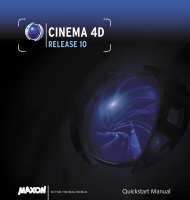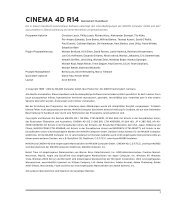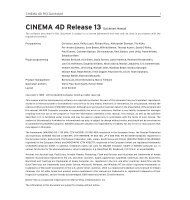Optional module - Maxon Computer
Optional module - Maxon Computer
Optional module - Maxon Computer
You also want an ePaper? Increase the reach of your titles
YUMPU automatically turns print PDFs into web optimized ePapers that Google loves.
228 CINEMA 4D R11 Quickstart – Non-Linear Animation<br />
• Select the Display tag in the Object Manager and then switch to the “Ghosting“ tab<br />
in the Attribute Manager<br />
• Activate the Enable option and click on the “Calculate Cache” button at the bottom<br />
of the Attribute Manger.<br />
That’s it! All you have to do now is fine-tune the Ghosting to fit your needs. For example, you can change the<br />
Draw and/or Shading Mode (click on the small arrow next to the Draw Mode parameter); you can use the Frame<br />
Before and Frame After values to define how many frames should be displayed before and after the current<br />
frame; a Frame Step value of 1 will display every frame. Raising this value to 2 would halve the number of frames,<br />
a value of 3 will display only a third of the frames and so on. This gives you an impression of how quickly and<br />
easily you can fine-tune Ghosting to suit your needs.<br />
Tips: The way in which HyperNURBS work presents 3D Ghosting with a limitation: If a Display tag has been<br />
assigned to a polygon mesh that is a Child of an active HyperNURBS object the Ghosting will not be displayed<br />
after the cache has been calculated. To resolve this you can either deactivate the HyperNURBS object before<br />
and reactivate it again after calculating the cache or assign the Display tag to the HyperNURBS object in the<br />
first place.<br />
3D Ghosting only works on objects that have been animated directly (e.g. a cube animated using Keyframes)<br />
without having to calculate the cache. If a mesh has been deformed by a skin a cache will have to be created.<br />
However, the cache must not be cleared every time a change is made to the animation. Simply click on “Calculate<br />
Cache“ and the 3D Ghosting data will be updated.<br />
Welcome to Projection Man<br />
1. Introduction<br />
Once you have completed this tutorial you will be able to save a great amount of working time and maybe even<br />
create scenes you never would have been able to without this tool. This tutorial is primarily geared towards<br />
matte painters but can also be used by any 3D artist to keep from having to texture a great number of objects.<br />
For those of you unfamiliar with the term “matte painting”, here is a brief description of what this is: Matte<br />
painters mostly work in the movie industry and create (paint) background imagery for movie scenes. These<br />
backgrounds are for the most part so realistic that the viewer assumes they are real-world backgrounds. An<br />
example of matte painting is a scene in which a king on his horse rides across a virtual landscape that, on the<br />
one hand, does not exist in the real world and on the other hand does not have to be built in 3D. The matte<br />
painter paints the desired background and the king and his horse are simply composited into the scene.<br />
Advancing technology has also made it possible to create matte paintings in 3D using a computer, which makes<br />
it possible to animate a camera and maintain a correct angle of view of the background. This would not be<br />
possible using traditional 2D techniques. The disadvantage (if you can call it that) to using 3D matte painting is<br />
that a “single image” cannot be used – the scene must be modeled and all objects must be textured. And this<br />
is exactly where Projection Man comes in.









